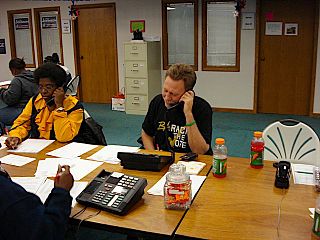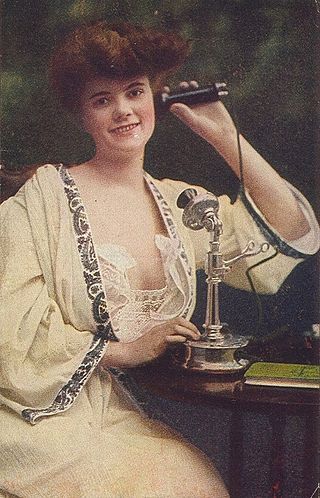A nuisance call is an unwanted and unsolicited telephone call. Common types of nuisance calls include prank calls, telemarketing calls, and silent calls. Obscene phone calls and other threatening calls are criminal acts in most jurisdictions, particularly when hate crime is involved. [1]
Unsolicited calls may also be used to initiate telephone frauds. Fax machines may also receive junk faxes via unsolicited calls. [2]
Caller ID provides some protection against unwanted calls, but can still be turned off by the calling party. Even where end-user caller ID is not available, calls are still logged, both in billing records at the originating telco and via automatic number identification, so the perpetrator's phone number can still be discovered in many cases. However, these do not provide complete protection: harassers can use payphones and, in some cases, caller ID (but not necessarily automatic number identification itself) can be spoofed or blocked. Mobile telephone abusers can (at some cost) use "throwaway" mobile phones or SIMs. Voice over IP users may send bogus caller ID or route calls through servers in multiple countries. Even in these cases, with sufficient law enforcement and telco effort, persistent abusers can often be tracked down by technical means. Call screening is another countermeasure against unsolicited calls. [3]
Most telephone companies have a department devoted to handling complaints regarding unsolicited phone calls. In criminal cases such as obscene or threatening phone calls, many police departments have dedicated resources devoted to dealing with such cases. In the United Kingdom, the communication regulator Ofcom offers a service to report on silent calls while the Telephone Preference Service (TPS) allows consumer to register on a do-not-call-list for marketing calls. [4]
On December 19, 2018, the Canadian Radio-television and Telecommunications Commission (CRTC) announced that beginning December 19, 2019, phone providers will be required to impose universal, network-level filtering of all calls that "[purport] to originate from telephone numbers that do not conform to established numbering plans". [5]

An emergency telephone number is a number that allows a caller to contact local emergency services for assistance. The emergency number differs from country to country; it is typically a three-digit number so that it can be easily remembered and dialed quickly. Some countries have a different emergency number for each of the different emergency services; these often differ only by the last digit.

Telemarketing is a method of direct marketing in which a salesperson solicits prospective customers to buy products, subscriptions or services, either over the phone or through a subsequent face to face or web conferencing appointment scheduled during the call. Telemarketing can also include recorded sales pitches programmed to be played over the phone via automatic dialing.
Caller identification is a telephone service, available in analog and digital telephone systems, including voice over IP (VoIP), that transmits a caller's telephone number to the called party's telephone equipment when the call is being set up. The caller ID service may include the transmission of a name associated with the calling telephone number, in a service called Calling Name Presentation (CNAM). The service was first defined in 1993 in International Telecommunication Union – Telecommunication Standardization Sector (ITU-T) Recommendation Q.731.3.
The National Do Not Call Registry is a database maintained by the United States federal government, listing the telephone numbers of individuals and families who have requested that telemarketers not contact them. Certain callers are required by federal law to respect this request. Separate laws and regulations apply to robocalls in the United States.
An obscene phone call is an unsolicited telephone call where a person uses profane and/or sexual language to interact with someone who may be known to them or may be a complete stranger. Making obscene telephone calls for sexual arousal or other sexual pleasure is known as telephone scatologia and is considered a form of exhibitionism.

Mobile phone spam is a form of spam, directed at the text messaging or other communications services of mobile phones or smartphones. As the popularity of mobile phones surged in the early 2000s, frequent users of text messaging began to see an increase in the number of unsolicited commercial advertisements being sent to their telephones through text messaging. This can be particularly annoying for the recipient because, unlike in email, some recipients may be charged a fee for every message received, including spam. Mobile phone spam is generally less pervasive than email spam, where in 2010 around 90% of email is spam. The amount of mobile spam varies widely from region to region. In North America, mobile spam steadily increased after 2008 and accounted for half of all mobile phone traffic by 2019. In parts of Asia up to 30% of messages were spam in 2012.

A telephone call or telephone conversation, also known as a phone call or voice call, is a connection over a telephone network between the called party and the calling party. Telephone calls started in the late 19th century. As technology has improved, a majority of telephone calls are made over a cellular network through mobile phones or over the internet with Voice over IP. Telephone calls are typically used for real-time conversation between two or more parties, especially when the parties cannot meet in person.
Phone fraud, or more generally communications fraud, is the use of telecommunications products or services with the intention of illegally acquiring money from, or failing to pay, a telecommunication company or its customers.
Junk faxes are a form of telemarketing where unsolicited advertisements are sent via fax transmission. Junk faxes are the faxed equivalent of spam or junk mail. Proponents of this advertising medium often use the terms broadcast fax or fax advertising to avoid the negative connotation of the term junk fax. Junk faxes are generally considered to be a nuisance since they waste toner, ink and paper in fax machines.

The Telephone Consumer Protection Act of 1991 (TCPA) was passed by the United States Congress in 1991 and signed into law by President George H. W. Bush as Public Law 102-243. It amended the Communications Act of 1934. The TCPA is codified as 47 U.S.C. § 227. The TCPA restricts telephone solicitations and the use of automated telephone equipment. The TCPA limits companies or debt collectors from calling clients or prospective customers using automatic dialing systems, artificial or prerecorded voice messages, SMS text messages, and fax machines. It also specifies several technical requirements for fax machines, autodialers, and voice messaging systems—principally with provisions requiring identification and contact information of the entity using the device to be contained in the message.
VoIP spam or SPIT is unsolicited, automatically dialed telephone calls, typically using voice over Internet Protocol (VoIP) technology.
The National Do Not Call List (DNCL) is a list administered by the Canadian Radio-television and Telecommunications Commission (CRTC) that enables residents of Canada to decide whether or not to receive telemarketing calls. It was first announced by the Government of Canada on 13 December 2004.

Cold calling is the solicitation of business from potential customers who have had no prior contact with the salesperson conducting the call. It is an attempt to convince potential customers to purchase either the salesperson's product or service. Generally, it is referred as an over-the-phone process, making it a source of telemarketing, but can also be done in-person by door-to-door salespeople. Though cold calling can be used as a legitimate business tool, scammers can use cold calling as well.
The Telephone Preference Service (TPS) is the United Kingdom's official do not call list. It allows businesses and individuals to opt out of unsolicited marketing calls.

Caller ID spoofing is a spoofing attack which causes the telephone network's Caller ID to indicate to the receiver of a call that the originator of the call is a station other than the true originating station. This can lead to a display showing a phone number different from that of the telephone from which the call was placed.
A robocall is a phone call that uses a computerized autodialer to deliver a pre-recorded message, as if from a robot. Robocalls are often associated with political and telemarketing phone campaigns, but can also be used for public service, emergency announcements, or scammers. Multiple businesses and telemarketing companies use auto-dialing software to deliver prerecorded messages to millions of users. Some robocalls use personalized audio messages to simulate an actual personal phone call. The service is also viewed as prone to association with scams.
Telemarketing fraud is fraudulent selling conducted over the telephone. The term is also used for telephone fraud not involving selling.
In many voice telephone networks, anonymous call rejection (ACR) is a calling feature implemented in software on the network that automatically screens out calls from callers who have blocked their caller ID information.
Caller Name Presentation (CNAP) or Caller Name Delivery (CNAM) is used in US-based telephone networks to provide name identification of the calling party. The CNAM information is most often displayed in Caller ID. The information could be the person's name or a company name. The caller's name can also be blocked and display “restricted”, or if technical failures occur “not available”.
STIR/SHAKEN, or SHAKEN/STIR, is a suite of protocols and procedures intended to combat caller ID spoofing on public telephone networks. Caller ID spoofing is used by robocallers to mask their identity or to make it appear the call is from a legitimate source, often a nearby phone number with the same area code and exchange, or from well-known agencies like the Internal Revenue Service or Ontario Provincial Police. This sort of spoofing is common for calls originating from voice-over-IP (VoIP) systems, which can be located anywhere in the world.